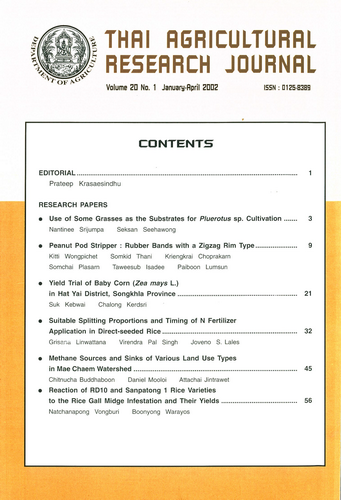Suitable Splitting Proportions and Timing of N Fertilizer Application in direct-seeded Rice
DOI:
https://doi.org/10.14456/thaidoa-agres.2002.4Keywords:
nitrogen management, direct-seeded rice, reproductive stageAbstract
Direct-seeded rice cultivation is continuously expanding due to lower labor costs, increasing need to intensify cropping, and availability of effective herbicides for weed control. but shifiting to direct seeding may affect stand establishment because of non-availability of field-tested nitrogen management technology as is known for the transplanted rice. This study was therefore, conducted for two wet and one dry season during 1999-2000 to determine the suitable splitting proportions and time of N application that could enhance grain yield of direct-seeded rice at Ubon Ratchathani, Thailand.
Regardless of season and rice variety used, 60 kg N/ha applied in three splits, i.e. 15 kg N/ha at 15 and 30 days after emergence (DAE) and the remaining 30 kg N/ha at 45 DAE consistently gave the highest grain yield. The crop that received this type of splitting proportion and time of N applicationhad the tallest plants, highest number of tillers, highest shoot biomass, higher leaf area index, higher N had the talles tplants, highest number of tillers, highest shoot biomas, higher leaf area index, higher N content of above ground plant parts and higher nitorgen uptake, and thus, the highest grain yield. Plant height, number of tillers, and N uptake were positively correlated with grain yield. Conversely, when half of the total amount of N rate was applied 5 DAE, and one-fourth at 20 and 35 DAE, grain yield and almost all other agronomic/growth parameters were lower. The results indicate that in direct-seeded rice, greater response to nitrogen application can be abtained when the nitrogen application was done at a time close to the reproductive stage, e.g. 45 DAE. There is greater demand of N at this stage. Higher number of tillers baring panicle can be attaining through higher seeding rate but tiller maintenance in direct-seeded rice was obtained through applying higher dose of N at a time close to the reproductive stage.
Downloads
Published
How to Cite
Issue
Section
License

This work is licensed under a Creative Commons Attribution-NonCommercial-NoDerivatives 4.0 International License.
Thai Agricultural Research Journal



